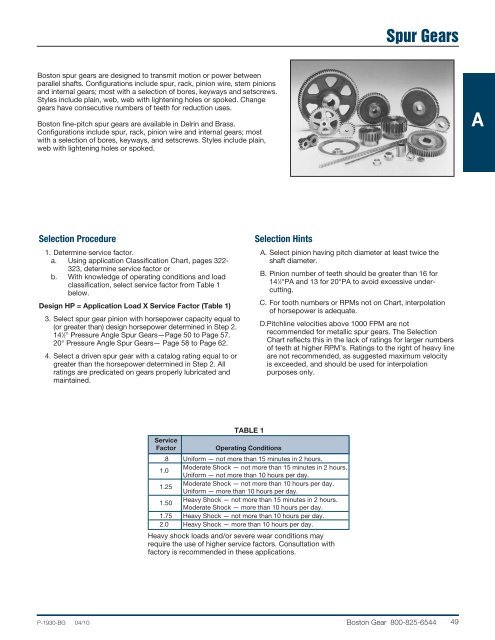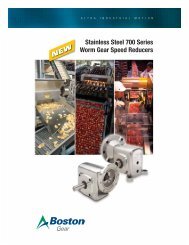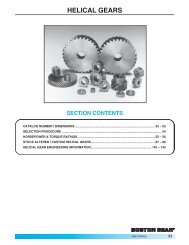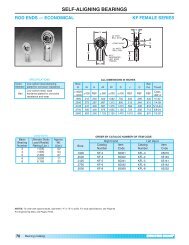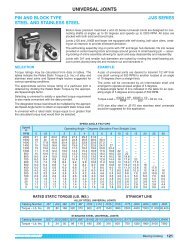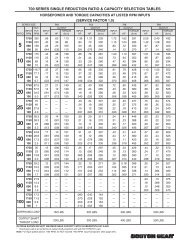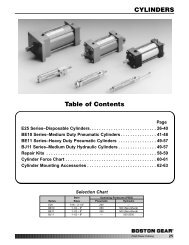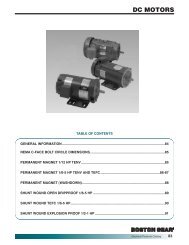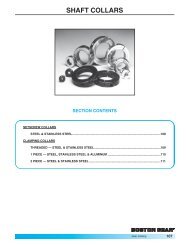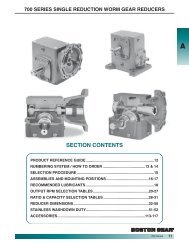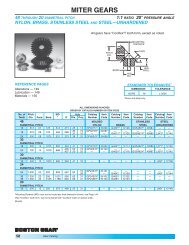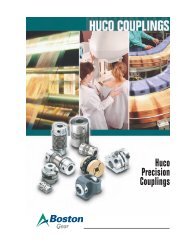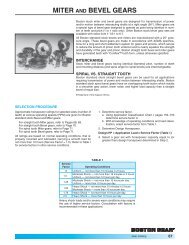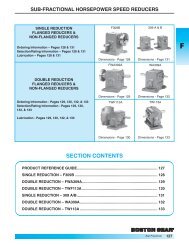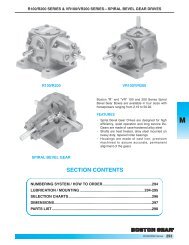Modified Stock Gearing - Boston Gear
Modified Stock Gearing - Boston Gear
Modified Stock Gearing - Boston Gear
Create successful ePaper yourself
Turn your PDF publications into a flip-book with our unique Google optimized e-Paper software.
Spur <strong>Gear</strong>s<br />
<strong>Boston</strong> spur gears are designed to transmit motion or power between<br />
parallel shafts. Configurations include spur, rack, pinion wire, stem pinions<br />
and internal gears; most with a selection of bores, keyways and setscrews.<br />
Styles include plain, web, web with lightening holes or spoked. Change<br />
gears have consecutive numbers of teeth for reduction uses.<br />
<strong>Boston</strong> fine-pitch spur gears are available in Delrin and Brass.<br />
Configurations include spur, rack, pinion wire and internal gears; most<br />
with a selection of bores, keyways, and setscrews. Styles include plain,<br />
web with lightening holes or spoked.<br />
A<br />
Selection Procedure<br />
1. Determine service factor.<br />
a. Using application Classification Chart, pages 322-<br />
323, determine service factor or<br />
b. With knowledge of operating conditions and load<br />
classification, select service factor from Table 1<br />
below.<br />
Design HP = Application Load X Service Factor (Table 1)<br />
3. Select spur gear pinion with horsepower capacity equal to<br />
(or greater than) design horsepower determined in Step 2.<br />
14 1 ⁄2° Pressure Angle Spur <strong>Gear</strong>s—Page 50 to Page 57.<br />
20° Pressure Angle Spur <strong>Gear</strong>s— Page 58 to Page 62.<br />
4. Select a driven spur gear with a catalog rating equal to or<br />
greater than the horsepower determined in Step 2. All<br />
ratings are predicated on gears properly lubricated and<br />
maintained.<br />
Selection Hints<br />
A. Select pinion having pitch diameter at least twice the<br />
shaft diameter.<br />
B. Pinion number of teeth should be greater than 16 for<br />
14 1 ⁄2°PA and 13 for 20°PA to avoid excessive under -<br />
cutting.<br />
C. For tooth numbers or RPMs not on Chart, interpolation<br />
of horsepower is adequate.<br />
D.Pitchline velocities above 1000 FPM are not<br />
recommended for metallic spur gears. The Selection<br />
Chart reflects this in the lack of ratings for larger numbers<br />
of teeth at higher RPM’s. Ratings to the right of heavy line<br />
are not recommended, as suggested maximum velocity<br />
is exceeded, and should be used for interpolation<br />
purposes only.<br />
TABLE 1<br />
Service<br />
Factor<br />
Operating Conditions<br />
.8 Uniform — not more than 15 minutes in 2 hours.<br />
1.0<br />
Moderate Shock — not more than 15 minutes in 2 hours.<br />
Uniform — not more than 10 hours per day.<br />
1.25<br />
Moderate Shock — not more than 10 hours per day.<br />
Uniform — more than 10 hours per day.<br />
1.50<br />
Heavy Shock — not more than 15 minutes in 2 hours.<br />
Moderate Shock — more than 10 hours per day.<br />
1.75 Heavy Shock — not more than 10 hours per day.<br />
2.0 Heavy Shock — more than 10 hours per day.<br />
Heavy shock loads and/or severe wear conditions may<br />
require the use of higher service factors. Consultation with<br />
factory is recommended in these applications.<br />
P-1930-BG 04/10 <strong>Boston</strong> <strong>Gear</strong> 800-825-6544 49


